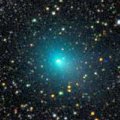
|
Now it is so bright as 8.2 mag (Apr. 10, Juan Jose Gonzalez). It will be observable at 8-9 mag in good condition from April to May. After that, it keeps observable for a long time until when it fades out in the Northern Hemisphere, although it will be low in July.
Date(TT) R.A. (2000) Decl. Delta r Elong. m1 Best Time(A, h)
Apr. 10 19 52.99 37 24.3 1.290 1.451 77 8.3 4:08 (255, 59)
Apr. 17 20 8.19 48 5.4 1.265 1.435 77 8.2 3:57 (234, 59)
|
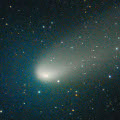
|
Now it is so bright as 9.2 mag (Mar. 20, Marco Goiato). It will be fading gradually after late May. But it keeps observable in a good condition for a long time. It keeps observable until autumn when it fades down to 16 mag.
Date(TT) R.A. (2000) Decl. Delta r Elong. m1 Best Time(A, h)
Apr. 10 14 13.29 -5 28.7 0.675 1.663 164 9.7 1:02 ( 0, 49)
Apr. 17 14 11.03 -5 6.5 0.685 1.683 170 9.9 0:33 ( 0, 50)
|
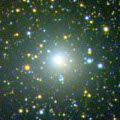
|
It reached up to 7.7 mag in last summer (Aug. 13, Chris Wyatt). It is fading now. It has already faded down to 11.5 mag (Mar. 20, Marco Goiato). In the Southern Hemisphere, it keeps observable for a long time after this. But in the Northern Hemisphere, it is only observable in the low sky in spring, then it will never be observable again.
Date(TT) R.A. (2000) Decl. Delta r Elong. m1 Best Time(A, h)
Apr. 10 20 20.56 -28 44.8 4.150 4.085 79 11.3 4:08 (320, 13)
Apr. 17 20 19.61 -29 56.4 4.062 4.126 86 11.3 3:57 (324, 15)
|
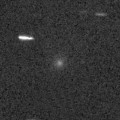
|
Bright new comet discovered at 11 mag in the extremely low sky at dawn. Now it is 10.7 mag (Mar. 27, Juan Jose Gonzalez). It was observed only about one week. It will never be observable again.
Date(TT) R.A. (2000) Decl. Delta r Elong. m1 Best Time(A, h)
Apr. 10 1 23.22 29 2.1 1.433 0.620 21 11.7 19:55 (128, -2)
Apr. 17 2 4.04 25 13.2 1.562 0.658 16 12.2 20:02 (124, -4)
|
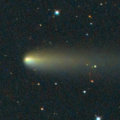
|
It brightened up to 9.5 mag on Jan. 13 (Juan Jose Gonzalez). Now it is still bright as 11.3 mag (Apr. 4, Juan Jose Gonzalez). However, it is fading more rapidly than expected. It will be observable in good condition for a long time after this in the Northern Hemisphere. It keeps visible visually until autumn. In mid March, the nuclear fragmentation was observed.
Date(TT) R.A. (2000) Decl. Delta r Elong. m1 Best Time(A, h)
Apr. 10 15 17.78 61 58.5 2.613 3.049 106 11.8 2:06 (180, 63)
Apr. 17 15 12.80 62 57.8 2.690 3.099 104 12.0 1:34 (180, 62)
|

|
It has been unobservable for a while, but now it is appearing in the morning sky. Now it is 10.2 mag, much brighter than expected (Apr. 10, Juan Jose Gonzalez). It will approach to the sun down to 0.4 A.U. in July, and it is expected to reach up to 4 mag. In the Northern Hemisphere, it is observable only until June.
Date(TT) R.A. (2000) Decl. Delta r Elong. m1 Best Time(A, h)
Apr. 10 22 52.09 -1 30.3 2.492 1.788 36 12.5 4:08 (275, 5)
Apr. 17 23 3.24 1 16.3 2.318 1.675 39 12.1 3:57 (274, 7)
|
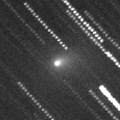
|
Hidetaka Sato reported that there was no condensation and it was very diffuse on Mar. 12. This comet seems to disintegrate. However, it is still reported so bright as 10.4 mag visually (Apr. 10, Carlos Labordena). In the Northern Hemisphere, it will be too low in early May. In the Southern Hemisphere, it keeps observable for a long time after this, but it keeps locating low.
Date(TT) R.A. (2000) Decl. Delta r Elong. m1 Best Time(A, h)
Apr. 10 4 6.30 28 1.9 0.998 0.773 45 12.6 19:55 (106, 27)
Apr. 17 4 42.32 20 11.1 1.162 0.843 45 12.7 20:02 ( 99, 23)
|
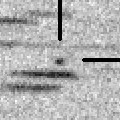
|
Now it is 15.9 mag (Apr. 9, C. Rinner, F. Kugel). It will be getting brighter rapidly in the morning sky. It keeps observable bright as 9-10 mag for a long time from spring to autumn.
Date(TT) R.A. (2000) Decl. Delta r Elong. m1 Best Time(A, h)
Apr. 10 19 44.40 -12 18.1 1.447 1.674 84 13.2 4:08 (317, 32)
Apr. 17 20 3.72 -11 47.1 1.364 1.639 86 12.8 3:57 (316, 32)
|
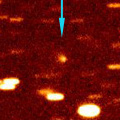
|
It brightened up to 15.5 mag in January (Jan. 31, C. Rinner, F. Kugel). It is not observable now. The condition of this apparition is bad. It will reach up to 11-12 mag from spring to autumn in 2010, but it is not observable.
Date(TT) R.A. (2000) Decl. Delta r Elong. m1 Best Time(A, h)
Apr. 10 1 15.24 15 34.3 2.624 1.637 7 13.2 19:55 (120,-13)
Apr. 17 1 35.33 16 54.4 2.589 1.597 6 13.0 3:57 (238,-13)
|

|
Now it is visible visually at 13.4 mag (Mar. 25, Chris Wyatt). It will brighten up to 12-13 mag in summer. But it locates somewhat low in the Northern Hemisphere.
Date(TT) R.A. (2000) Decl. Delta r Elong. m1 Best Time(A, h)
Apr. 10 20 12.96 -24 59.9 2.419 2.452 80 13.4 4:08 (319, 17)
Apr. 17 20 23.44 -24 58.6 2.340 2.457 84 13.3 3:57 (320, 18)
|

|
Great outburst up to 11 mag occured on Feb. 2. Now it is still bright as 12.5 mag (Apr. 10, Carlos Labordena).
Date(TT) R.A. (2000) Decl. Delta r Elong. m1 Best Time(A, h)
Apr. 10 9 16.33 13 25.0 5.678 6.204 117 13.7 20:02 ( 0, 68)
Apr. 17 9 16.13 13 23.8 5.781 6.205 110 13.8 20:02 ( 18, 67)
|

|
Bright new comet. Now it is 13.2 mag (Apr. 5, Juan Jose Gonzalez). It will become low in the evening sky very rapidly, and it will not be observable in early May.
Date(TT) R.A. (2000) Decl. Delta r Elong. m1 Best Time(A, h)
Apr. 10 4 24.63 24 16.0 1.613 1.210 48 14.4 19:55 (101, 29)
Apr. 17 4 44.79 19 40.9 1.695 1.225 45 14.5 20:02 ( 98, 23)
|
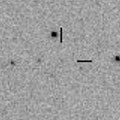
|
It was observed as 15.6 mag at the end of last year (Dec. 6, A. Maury, J. B. de Vanssay, F. Mallia, F. Kugel). It will be 14 mag from winter to spring in 2010. But the condition is bad. Now it is not observable. In the Northern Hemisphere, it will appear in the morning sky at 15 mag in late May, then it keeps observable while fading gradually after that.
Date(TT) R.A. (2000) Decl. Delta r Elong. m1 Best Time(A, h)
Apr. 10 0 42.96 15 45.1 2.760 1.786 10 14.5 4:08 (245, -7)
Apr. 17 0 56.38 18 57.5 2.770 1.809 13 14.6 3:57 (243, -5)
|
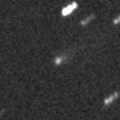
|
Now it is visible visually at 14.5 mag (Mar. 15, Juan Jose Gonzalez). It will be bright as 14-15 mag in spring. It keeps observable for a long time until September when it becomes fainter than 18 mag.
Date(TT) R.A. (2000) Decl. Delta r Elong. m1 Best Time(A, h)
Apr. 10 15 55.89 -30 36.7 0.848 1.715 135 15.0 2:44 ( 0, 24)
Apr. 17 16 2.36 -30 52.4 0.811 1.712 140 14.9 2:23 ( 0, 24)
|
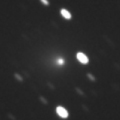
|
It brightened up to 11.5 mag in January (Jan. 12, Juan Jose Gonzalez). It is still bright as 13.1 mag (Mar. 13, Carlos Labordena). It will be getting fainter and lower rapidly after this. It will be unobservable in June.
Date(TT) R.A. (2000) Decl. Delta r Elong. m1 Best Time(A, h)
Apr. 10 7 5.24 19 37.9 1.957 2.128 85 15.1 19:55 ( 69, 59)
Apr. 17 7 18.04 19 44.8 2.051 2.147 81 15.7 20:02 ( 74, 55)
|

|
The condition of this apparition is very bad. It will go away without any observations.
Date(TT) R.A. (2000) Decl. Delta r Elong. m1 Best Time(A, h)
Apr. 10 2 21.22 14 24.5 2.134 1.220 17 15.3 19:55 (108, -1)
Apr. 17 2 47.63 15 47.5 2.119 1.200 17 15.1 20:02 (111, -2)
|

|
It brightened up to 11 mag in spring and summer in 2009. Appearing in the morninig sky again. It keeps observable after this until autumn when it becomes fainter than 18 mag while fading gradually. But it locates somewhat low in the Northern Hemisphere.
Date(TT) R.A. (2000) Decl. Delta r Elong. m1 Best Time(A, h)
Apr. 10 19 50.76 -24 38.5 2.705 2.799 84 15.2 4:08 (323, 20)
Apr. 17 19 57.12 -24 31.3 2.636 2.825 90 15.3 3:57 (326, 22)
|
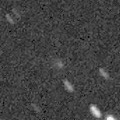
|
It became bright more rapidly than expected. Now it is 14.8 mag (Apr. 6, Catalina Sky Survey). It will be visible visually. It keeps 15 mag for a while. But it will be getting lower gradually in the evening sky.
Date(TT) R.A. (2000) Decl. Delta r Elong. m1 Best Time(A, h)
Apr. 10 5 0.27 31 44.2 1.919 1.623 57 15.4 19:55 (105, 39)
Apr. 17 5 23.66 32 38.3 1.961 1.629 56 15.3 20:02 (107, 37)
|
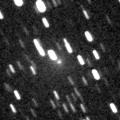
|
Now it is 15.1 mag (Apr. 3, Ken-ichi Kadota). It has a very faint large coma. It was observed so bright as 13.5 mag in January (Jan. 16, Michael Jager).
Date(TT) R.A. (2000) Decl. Delta r Elong. m1 Best Time(A, h)
Apr. 10 4 2.33 74 45.7 1.415 1.446 71 15.4 19:55 (162, 37)
Apr. 17 5 30.50 76 26.1 1.412 1.469 72 15.4 20:02 (164, 40)
|
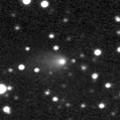
|
It became visible visually at 13.3 mag in winter (Feb. 3, Marco Goiato). Now it is fading slowly. It will be getting lower in the evening sky after this. It will be too low to observe in July.
Date(TT) R.A. (2000) Decl. Delta r Elong. m1 Best Time(A, h)
Apr. 10 6 31.65 24 30.5 1.833 1.886 77 15.4 19:55 ( 84, 55)
Apr. 17 6 47.67 24 40.2 1.893 1.884 74 15.5 20:02 ( 87, 51)
|

|
Now it is 15.6 mag (Mar. 17, Toshiyuki Takahashi). It was expected to be observable at 15 mag in good condition from winter to spring. But actually, it had been much fainter than expected until January. However, it is brightening very rapidly in February.
Date(TT) R.A. (2000) Decl. Delta r Elong. m1 Best Time(A, h)
Apr. 10 10 8.36 21 18.0 1.500 2.242 126 15.4 20:54 ( 0, 76)
Apr. 17 10 10.67 20 38.2 1.565 2.244 120 15.5 20:29 ( 0, 76)
|

|
Now it is 15.3 mag (Mar. 26, P. Concari, S. Foglia, G. Galli, M. Tombelli). It was observed as 15-16 mag in early 2009. In 2010, it will be observable at 16 mag in good condition from winter to spring.
Date(TT) R.A. (2000) Decl. Delta r Elong. m1 Best Time(A, h)
Apr. 10 13 43.68 -2 51.7 2.671 3.663 171 15.4 0:33 ( 0, 52)
Apr. 17 13 39.24 -2 31.8 2.672 3.669 172 15.4 0:01 ( 0, 52)
|
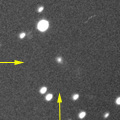
|
Now it is 15.5 mag (Feb. 20, S. Plaksa, E. Bryssinck). It is also visible visually at 14.5 mag (Apr. 10, Juan Jose Gonzalez). It keeps observable at 15 mag for a long time in 2010.
Date(TT) R.A. (2000) Decl. Delta r Elong. m1 Best Time(A, h)
Apr. 10 18 2.61 27 37.3 4.413 4.721 101 15.5 4:08 (306, 78)
Apr. 17 18 3.92 29 19.2 4.344 4.705 105 15.4 3:57 (312, 82)
|
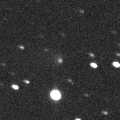
|
Brightening more slowly than expected. It will be observable at 13-14 mag for a long time from 2011 to 2012. It is getting higher gradually after this. In 2010, it is observable at 15-16 mag in good condition from spring to autumn.
Date(TT) R.A. (2000) Decl. Delta r Elong. m1 Best Time(A, h)
Apr. 10 21 59.74 0 49.0 8.069 7.446 48 16.1 4:08 (281, 17)
Apr. 17 22 0.29 1 3.1 7.939 7.412 55 16.0 3:57 (283, 20)
|

|
It brightened up to 13 mag and observed visually from 2007 to 2009. Due to the far distance, it is bright as 14.8 mag still now (Apr. 7, E. Bryssinck, A. Novichonok, D. Chestnov, L. Elenin). It will be observable in good condition again until spring.
Date(TT) R.A. (2000) Decl. Delta r Elong. m1 Best Time(A, h)
Apr. 10 12 18.82 42 55.3 7.341 7.994 127 16.4 23:03 (180, 82)
Apr. 17 12 12.33 43 0.1 7.435 8.027 123 16.4 22:30 (180, 82)
|
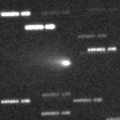
|
It reached up to 15.1 mag on Mar. 10 (Hidetaka Sato). It brightened up to 11 mag in outburst in 2003. However, it did not become so bright in this apparition. Now it is 16.5 mag (Apr. 9, Hidetaka Sato). It will be getting lower and fainter rapidly after this. It will be fainter than 18 mag in May.
Date(TT) R.A. (2000) Decl. Delta r Elong. m1 Best Time(A, h)
Apr. 10 5 43.78 22 47.6 1.545 1.466 66 16.4 19:55 ( 89, 44)
Apr. 17 6 8.94 22 17.8 1.606 1.497 65 16.6 20:02 ( 90, 42)
|
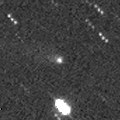
|
Now it is 17.2 mag (Apr. 4, Ken-ichi Kadota). It keeps observable in good condition for a while, but it will be fading after this. It will be fainter than 18 mag in July.
Date(TT) R.A. (2000) Decl. Delta r Elong. m1 Best Time(A, h)
Apr. 10 13 21.74 29 8.1 2.562 3.416 143 16.5 0:12 ( 0, 84)
Apr. 17 13 4.00 28 36.4 2.625 3.456 140 16.6 23:20 ( 0, 83)
|
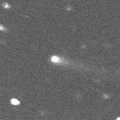
|
Now it is 16.1 mag (Mar. 16, Mt. Lemmon Survey). This comet tends to brighten after the perihelion passage. It will be observable at 16 mag in 2010 and 2011.
Date(TT) R.A. (2000) Decl. Delta r Elong. m1 Best Time(A, h)
Apr. 10 5 21.66 23 46.1 3.556 3.199 61 16.5 19:55 ( 93, 40)
Apr. 17 5 31.08 23 49.1 3.643 3.203 56 16.6 20:02 ( 97, 35)
|

|
It brightned up to 10 mag from late 2008 to early 2009. Now it is fading. It has already faded down to 16.9 mag (Mar. 13, Ken-ichi Kadota). It will be fainter than 18 mag in June.
Date(TT) R.A. (2000) Decl. Delta r Elong. m1 Best Time(A, h)
Apr. 10 9 38.63 4 3.6 5.440 6.072 125 17.1 20:24 ( 0, 59)
Apr. 17 9 37.75 4 5.1 5.587 6.125 118 17.2 20:02 ( 3, 59)
|
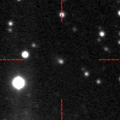
|
Now it is 17.3 mag (Mar. 30, Yasukazu Ikari). It keeps observable at 17 mag until spring. It will reach up to 14 mag and will be observable in good condition in the next winter.
Date(TT) R.A. (2000) Decl. Delta r Elong. m1 Best Time(A, h)
Apr. 10 5 57.06 54 55.7 4.340 4.154 72 17.2 19:55 (136, 52)
Apr. 17 5 59.70 53 14.4 4.397 4.110 66 17.2 20:02 (133, 47)
|
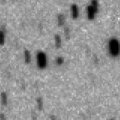
|
It was observed at 17.5 mag in 2009 spring. It will be observable at 17.5 mag again in 2010 spring. However, it locates low in the Northern Hemisphere.
Date(TT) R.A. (2000) Decl. Delta r Elong. m1 Best Time(A, h)
Apr. 10 13 41.27 -20 58.1 4.991 5.965 165 17.2 0:30 ( 0, 34)
Apr. 17 13 38.46 -20 0.7 4.982 5.974 170 17.2 0:00 ( 0, 35)
|

|
It brightened up to 13 mag in major outburst in 2005. It was recovered at 20.7 mag in 2009 January. However, no observations have been reported after 2009 April. The current brightness is quite uncertain.
Date(TT) R.A. (2000) Decl. Delta r Elong. m1 Best Time(A, h)
Apr. 10 13 15.61 -22 49.4 2.423 3.400 164 17.4 0:05 ( 0, 32)
Apr. 17 13 9.76 -22 25.2 2.392 3.375 165 17.3 23:27 ( 0, 33)
|
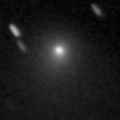
|
Now it is 17.4 mag (Feb. 17, Hidetaka Sato). It will be fainter than 18 mag in July.
Date(TT) R.A. (2000) Decl. Delta r Elong. m1 Best Time(A, h)
Apr. 10 19 0.27 36 49.5 6.515 6.556 87 17.4 4:08 (258, 70)
Apr. 17 19 1.03 37 45.6 6.511 6.607 91 17.4 3:57 (255, 73)
|
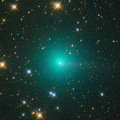
|
It brightened up to 6.7 mag in 2009 June (June 9, Marco Goiato). Now it is fading. It has already faded down to 17.5 mag (Mar. 31, Hidetaka Sato). It will be fainter than 18 mag in May.
Date(TT) R.A. (2000) Decl. Delta r Elong. m1 Best Time(A, h)
Apr. 10 10 18.40 57 20.4 3.441 3.837 105 17.4 21:03 (180, 68)
Apr. 17 10 5.45 56 49.0 3.601 3.900 99 17.6 20:23 (180, 68)
|
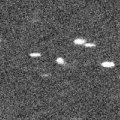
|
Now it is 17.7 mag (Mar. 21, Hidetaka Sato). It will reach up to 17 mag in spring and summer.
Date(TT) R.A. (2000) Decl. Delta r Elong. m1 Best Time(A, h)
Apr. 10 20 46.57 -2 14.7 3.553 3.299 67 17.4 4:08 (296, 29)
Apr. 17 20 52.05 -2 50.9 3.469 3.311 72 17.4 3:57 (299, 31)
|
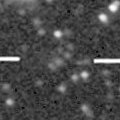
|
Now it is 17.3 mag (Jan. 23, Ken-ichi Kadota). It keeps observable at 17.5 mag in good condition for a long time in 2010.
Date(TT) R.A. (2000) Decl. Delta r Elong. m1 Best Time(A, h)
Apr. 10 23 15.79 73 15.6 5.134 4.844 67 17.4 4:08 (200, 34)
Apr. 17 23 18.80 74 20.0 5.145 4.843 67 17.4 3:57 (199, 35)
|

|
Now it is observable at 17.5 mag in good condition. However, it will be fainter than 18 mag in May.
Date(TT) R.A. (2000) Decl. Delta r Elong. m1 Best Time(A, h)
Apr. 10 11 30.57 -2 10.6 1.816 2.751 153 17.7 22:16 ( 0, 53)
Apr. 17 11 28.60 -1 26.2 1.860 2.753 146 17.7 21:46 ( 0, 54)
|
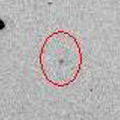
|
Now it is 17.4 mag (Mar. 6, C. Rinner, F. Kugel). It will reach up to 15 mag and will be observable in good condition from autum to winter in 2010. In the Northern Hemisphere, it keeps observable for a long time while it is brightening gradually.
Date(TT) R.A. (2000) Decl. Delta r Elong. m1 Best Time(A, h)
Apr. 10 9 41.89 72 15.0 3.754 3.937 93 17.8 20:27 (180, 53)
Apr. 17 9 25.70 72 9.3 3.790 3.886 87 17.8 20:02 (178, 53)
|

|
New periodic comet which brightened up to 14 mag in 2004 and 2005. It should be observable at 18 mag also around the aphelion. However, no observations have been reported since 2008 January. It seems to have faded out rapidly. Now it is fainter than 20.4 mag actually (Sept. 16, Leonid Elenin).
Date(TT) R.A. (2000) Decl. Delta r Elong. m1 Best Time(A, h)
Apr. 10 6 26.60 30 52.9 5.000 4.856 76 20.4 19:55 ( 95, 56)
Apr. 17 6 30.63 30 48.6 5.096 4.846 70 20.4 20:02 ( 98, 50)
|
|
![]()
 C/2009 O2 ( Catalina )
C/2009 O2 ( Catalina ) 10P/Tempel 2
10P/Tempel 2 43P/Wolf-Harrington
43P/Wolf-Harrington 65P/Gunn
65P/Gunn 29P/Schwassmann-Wachmann 1
29P/Schwassmann-Wachmann 1 C/2010 G1 ( Boattini )
C/2010 G1 ( Boattini ) 126P/IRAS
126P/IRAS P/2010 A5 ( LINEAR )
P/2010 A5 ( LINEAR ) 118P/Shoemaker-Levy 4
118P/Shoemaker-Levy 4 104P/Kowal 2
104P/Kowal 2 116P/Wild 4
116P/Wild 4 P/2010 A3 ( Hill )
P/2010 A3 ( Hill ) C/2009 U3 ( Hill )
C/2009 U3 ( Hill ) 30P/Reinmuth 1
30P/Reinmuth 1 94P/Russell 4
94P/Russell 4 74P/Smirnova-Chernykh
74P/Smirnova-Chernykh C/2008 FK75 ( Lemmon-Siding Spring )
C/2008 FK75 ( Lemmon-Siding Spring ) C/2006 S3 ( LONEOS )
C/2006 S3 ( LONEOS ) C/2005 L3 ( McNaught )
C/2005 L3 ( McNaught ) 157P/Tritton
157P/Tritton C/2008 N1 ( Holmes )
C/2008 N1 ( Holmes ) 203P/2008 R4 ( Korlevic )
203P/2008 R4 ( Korlevic ) C/2006 OF2 ( Broughton )
C/2006 OF2 ( Broughton ) C/2010 B1 ( Cardinal )
C/2010 B1 ( Cardinal ) C/2009 F2 ( McNaught )
C/2009 F2 ( McNaught ) 213P/2009 B3 ( Van Ness )
213P/2009 B3 ( Van Ness ) C/2006 Q1 ( McNaught )
C/2006 Q1 ( McNaught ) C/2008 Q3 ( Garradd )
C/2008 Q3 ( Garradd ) C/2009 K2 ( Catalina )
C/2009 K2 ( Catalina ) C/2007 VO53 ( Spacewatch )
C/2007 VO53 ( Spacewatch ) 235P/2010 F2 ( LINEAR )
235P/2010 F2 ( LINEAR ) C/2009 Y1 ( Catalina )
C/2009 Y1 ( Catalina ) P/2004 F3 ( NEAT )
P/2004 F3 ( NEAT )![]()
































